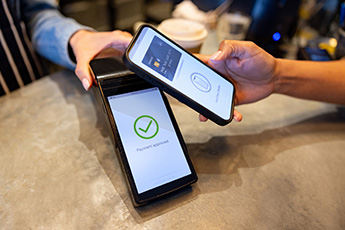There are now many versions of the classic David and Goliath tale, celebrating underdogs no matter the time period or place. Editors especially love to use the reference in headlines for stories of sporting matches, "Haye relishes underdog role in 'David and Goliath' fight with Nikolai Valuev;” business, "On Internet, David-and-Goliath Battle Over Instant Messages;" science, "David and Goliath: How a tiny spider catches much larger prey;" politics, "Dissent in Cuba: David and Goliath;" and social justice, "David-and-Goliath Sage Brings Cable to Skid Row.”Is there a new David and Goliath story brewing in the financial services industry?Zelle’s dominance and cost spurred the development of an alternate payment system designed for CFIs. The question is, will its open architecture be enough to woo users and secure a place in the competitive P2P payment realm? The new payment system developed by community banks raises some important questions in P2P payments: Does the world really need another payment system? And is an open system like this new one a useful addition? How CHUCK stacks up
CHUCK, the new payment system, was designed with community financial institutions (CFIs) in mind. It has attracted just a handful of community banks, although the coalition behind the innovation consists of about 60 members. With about 4,700 CFIs, there’s lots of room for expansion. But CHUCK has to overcome a huge lead by the dominant bank P2P payment system, Zelle, which is already working with thousands of financial institutions, including many community banks. Zelle says that 85% of its banking network consists of regional or community financial institutions, primarily CFIs with $1B or less in assets. Pricing differs between payment systems
That market domination has been an inspiration to the developers of CHUCK, who sense that CFIs feel like they might be second-class citizens in a closed system like Zelle, that was created around some of the nation’s largest banks. Pricing is tied to volume, and smaller banks can end up paying more per transaction. That can get expensive. CHUCK pitches itself as a cheaper alternative.Becoming a disruptor in order to succeed
In addition, Zelle requires both sides of a payment to use the app. CHUCK is built on open architecture that doesn’t require a separate app. The open architecture allows the customer of a participating CFI to send and receive payments in a number of ways, including through Venmo, without actually using any separate apps. The plan is for CHUCK to continue adding payment options, as well as new innovations over time. To understand where CHUCK fits in to the P2P world, it helps to keep in perspective how new this all is. PayPal started the trend with its introduction in 1998. Venmo arrived in 2009, only to be bought out by PayPal in 2012. Big banks, seeing the competitive threat from independent P2P payments, jumped in with their own offering. Zelle began in 2017 as a project of seven of the nation’s largest banks, led by Bank of America. They still own Zelle’s parent company, Early Warning Systems. Zelle started by wooing thousands of big bank customers and soon soared to the top of the bank P2P payment hierarchy.CHUCK represents a targeting on smaller financial institutions and their customers, instead of P2P giants. It is those customers who will ultimately decide if another P2P payment system is needed, and if the open architecture idea resonates. Popularity with users is what made PayPal an initial success. The innovations of Venmo helped it to capture even more users. And the effectiveness of Zelle enabled big banks to become major players in P2P payments. Success in tech often depends on being a disrupter. CHUCK is trying to disrupt the P2P world in favor of CFIs. Its challenge is to win over legions of CFI customers. At the moment, CHUCK is a fledgling alternative to Zelle. But if it grows into a strong competitor, it will be interesting to see what that means for Zelle.
CHUCK, the new payment system, was designed with community financial institutions (CFIs) in mind. It has attracted just a handful of community banks, although the coalition behind the innovation consists of about 60 members. With about 4,700 CFIs, there’s lots of room for expansion. But CHUCK has to overcome a huge lead by the dominant bank P2P payment system, Zelle, which is already working with thousands of financial institutions, including many community banks. Zelle says that 85% of its banking network consists of regional or community financial institutions, primarily CFIs with $1B or less in assets. Pricing differs between payment systems
That market domination has been an inspiration to the developers of CHUCK, who sense that CFIs feel like they might be second-class citizens in a closed system like Zelle, that was created around some of the nation’s largest banks. Pricing is tied to volume, and smaller banks can end up paying more per transaction. That can get expensive. CHUCK pitches itself as a cheaper alternative.Becoming a disruptor in order to succeed
In addition, Zelle requires both sides of a payment to use the app. CHUCK is built on open architecture that doesn’t require a separate app. The open architecture allows the customer of a participating CFI to send and receive payments in a number of ways, including through Venmo, without actually using any separate apps. The plan is for CHUCK to continue adding payment options, as well as new innovations over time. To understand where CHUCK fits in to the P2P world, it helps to keep in perspective how new this all is. PayPal started the trend with its introduction in 1998. Venmo arrived in 2009, only to be bought out by PayPal in 2012. Big banks, seeing the competitive threat from independent P2P payments, jumped in with their own offering. Zelle began in 2017 as a project of seven of the nation’s largest banks, led by Bank of America. They still own Zelle’s parent company, Early Warning Systems. Zelle started by wooing thousands of big bank customers and soon soared to the top of the bank P2P payment hierarchy.CHUCK represents a targeting on smaller financial institutions and their customers, instead of P2P giants. It is those customers who will ultimately decide if another P2P payment system is needed, and if the open architecture idea resonates. Popularity with users is what made PayPal an initial success. The innovations of Venmo helped it to capture even more users. And the effectiveness of Zelle enabled big banks to become major players in P2P payments. Success in tech often depends on being a disrupter. CHUCK is trying to disrupt the P2P world in favor of CFIs. Its challenge is to win over legions of CFI customers. At the moment, CHUCK is a fledgling alternative to Zelle. But if it grows into a strong competitor, it will be interesting to see what that means for Zelle.




